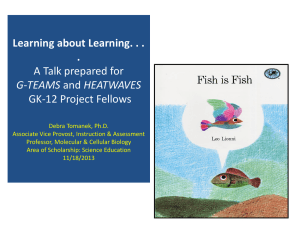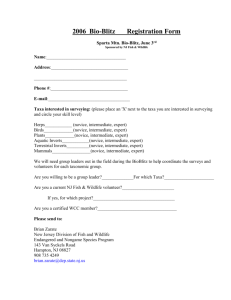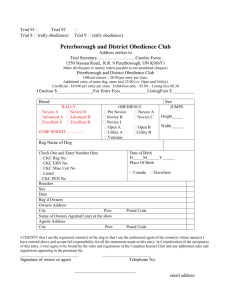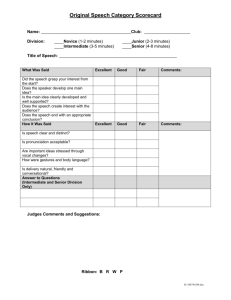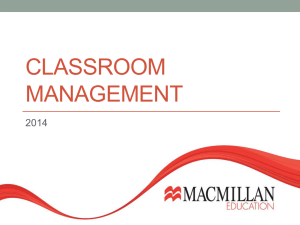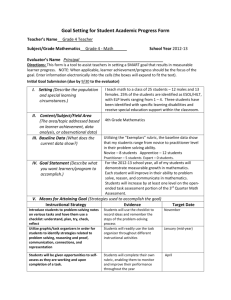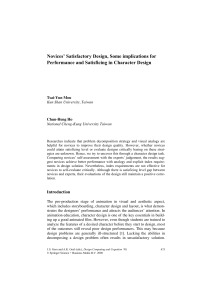Novice to Expert: How Do Professionals Learn
advertisement
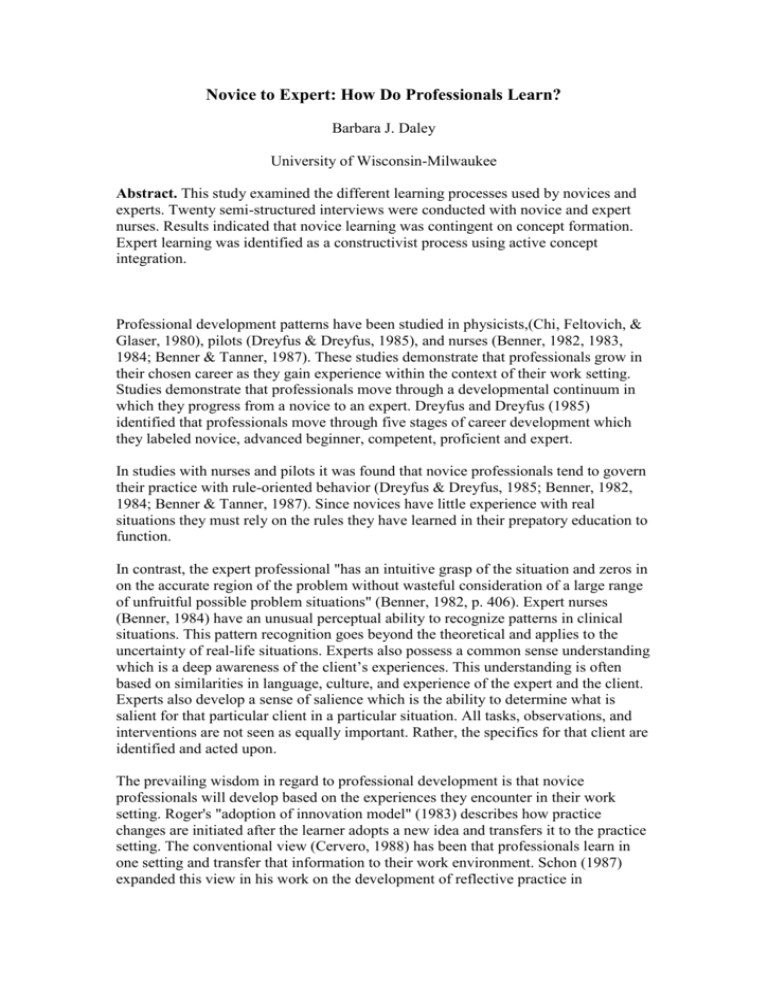
Novice to Expert: How Do Professionals Learn? Barbara J. Daley University of Wisconsin-Milwaukee Abstract. This study examined the different learning processes used by novices and experts. Twenty semi-structured interviews were conducted with novice and expert nurses. Results indicated that novice learning was contingent on concept formation. Expert learning was identified as a constructivist process using active concept integration. Professional development patterns have been studied in physicists,(Chi, Feltovich, & Glaser, 1980), pilots (Dreyfus & Dreyfus, 1985), and nurses (Benner, 1982, 1983, 1984; Benner & Tanner, 1987). These studies demonstrate that professionals grow in their chosen career as they gain experience within the context of their work setting. Studies demonstrate that professionals move through a developmental continuum in which they progress from a novice to an expert. Dreyfus and Dreyfus (1985) identified that professionals move through five stages of career development which they labeled novice, advanced beginner, competent, proficient and expert. In studies with nurses and pilots it was found that novice professionals tend to govern their practice with rule-oriented behavior (Dreyfus & Dreyfus, 1985; Benner, 1982, 1984; Benner & Tanner, 1987). Since novices have little experience with real situations they must rely on the rules they have learned in their prepatory education to function. In contrast, the expert professional "has an intuitive grasp of the situation and zeros in on the accurate region of the problem without wasteful consideration of a large range of unfruitful possible problem situations" (Benner, 1982, p. 406). Expert nurses (Benner, 1984) have an unusual perceptual ability to recognize patterns in clinical situations. This pattern recognition goes beyond the theoretical and applies to the uncertainty of real-life situations. Experts also possess a common sense understanding which is a deep awareness of the client’s experiences. This understanding is often based on similarities in language, culture, and experience of the expert and the client. Experts also develop a sense of salience which is the ability to determine what is salient for that particular client in a particular situation. All tasks, observations, and interventions are not seen as equally important. Rather, the specifics for that client are identified and acted upon. The prevailing wisdom in regard to professional development is that novice professionals will develop based on the experiences they encounter in their work setting. Roger's "adoption of innovation model" (1983) describes how practice changes are initiated after the learner adopts a new idea and transfers it to the practice setting. The conventional view (Cervero, 1988) has been that professionals learn in one setting and transfer that information to their work environment. Schon (1987) expanded this view in his work on the development of reflective practice in professionals, but stopped short of identifying the actual learning processes in reflective practice. In contrast to the above views, Daley (1997) found in a study of nurses who attended continuing education programs that experienced professionals do not apply or transfer knowledge from theory to practice. Rather, they go through a complicated process of constructing a knowledge base in practice. Constructing a knowledge base involved the integration of thinking, feeling, and acting segments of the professional role. Even though previous research clearly articulates a pattern of professional development, there are many outstanding and unanswered questions. One of these unanswered questions is: Do novice professionals learn in fundamentally different ways than expert professionals? The purpose of this study was to develop distinctions between the learning processes that underlie the novice to expert continuum of professional practice development. Research Questions A qualitative interpretivist approach (Guba & Lincoln, 1989) was used to study the following research questions: 1. What different learning processes are used by novice and expert practitioners? 2. How do those learning processes contribute to professional practice development? 3. What factors limit, change or alter learning process of novices and experts? Methodology Twenty nurses served as the purposive sample for this study, ten novice practitioners and ten expert practitioners. Novices and experts, identified by employers and peers, were invited to participate in the study. Two data collection methods were employed, interviews and clinical narratives. Semi-structured interviews were used to examine how nurses learned to think in clinical practice. Specifically, the interviews probed how novices and experts acquired new information, how they thought in clinical practice, how they learned from experience and how they made connections between different clinical cases. Additionally, novices and experts were asked to write clinical narratives that described actual clinical cases in which they felt significant learning occurred. These narratives addressed the client case, what was learned, how that learning changed or altered their practice and how they learned to learn in practice. Interview and clinical narrative data were transcribed and analyzed using a modified constant comparative method (Glaser and Strauss, 1973). Data analysis strategies included the use of concept maps (Novak and Gowin, 1984), category themes, and a system of matrices to compare group and individual data. Results Preliminary findings indicated that novice nurses tended to learn through more formal mechanisms, including review of policy or procedures, attendance at continuing education programs and reading journals. Novices appeared to learn through a process of concept formation. Experts, however, seemed to use more informal mechanisms, including consulting peers and other health care professionals. Experts constructed a knowledge base for themselves in the context of their practice. They obtained information from multiple sources, processed that information through peer-based dialogue, and changed their practice based on the revised meanings they created. Additionally, experts in this study, described themselves in two ways. Some described themselves as "serving their clients" and others described themselves as "a resource to my peers." These descriptions were often influenced by the specific role the expert played in their organization and impacted how the expert learned from their practice. Different Learning Processes of Novices and Experts. The results of this study indicated that novices and experts used different learning processes. Novice learning processes (See Figure 1) tended to be contingent on the process of concept formation and how that process was affected by fear, mistakes and the need for validation. To form concepts, novices described how they spent a great deal of time "just soaking up information". One nurse described how she felt like a "sponge" and continually tried to absorb as much as she could Figure 1: Novice Learning Processes hold. Novices described how they "did not even know, what they did not know" so they would tend to "adapt to the ideas of others". "Everything I am learning is new", stated one novice, "so I just take it in and try to remember it". One nurse stated, "You know it’s like that movie, ‘just show me the money’, well, just show me the procedure! I just need to learn how to do it." In this study, novices described how they were still forming concepts and striving to "sort it all out". Novices described a process of concept formation similar to that defined by David Ausubel (1978). "In concept formation, the learner generates hypotheses or problemsolving propositions that aim at defining, the abstracted criterial attributes of the concept to be learned" (Ausubel, 1978, p. 100). However, this concept formation process was then affected by the novice’s feelings about the context of their practice. Novices described feeling "overwhelmed", "scared to death" and they were "terrified of making a mistake". Novices described how they "needed validation" for procedures and ways of acting in their clinical practice. Novices used the learning strategies of "asking experts, particularly the physician", "looking it up", and "taking formal courses", but these strategies were used when the novice was directed to do so. Novices indicated that rather than deciding what to learn they waited to be told. One novice indicated, "Sometimes I feel so overwhelmed, I just need to be spoon-fed the information". Expert learning, on the other hand, tended to be constructivist learning (See Figure 2). Experts solidly grounded their learning in the needs of their clients and the context of their practice. Experts indicated that they "had a blueprint in their mind" of what their client needed and would make sure they had the information needed to meet those needs. Experts also indicated that they would actively learn new information because "that is what I need to know to work here". One nurse practitioner described how she identified that she was seeing more and more clients in need of pap smears. Since her educational background happened to be in gerontology, she had not developed this particular skill. The learning action she initiated was to arrange time with the OBGYN nurse practitioners in her clinic so that she could add this skill to her knowledge base. This nurse took a very active role in seeking out the information she needed to provide care to her clients. Experts also described that this active integration of concepts included their ability to "improvise", to "pick up little things", to "draw on other professional experiences", and to "draw on personal experiences". Experts indicated that both their personal and professional maturity contributed to being able to "put together the big picture". Experts viewed formal learning opportunities as "background material" and felt that it was "being in the practice that mattered". Experts would use learning strategies of reading, library research, and discussion with colleagues. The difference was that for experts this was a much more active and self-initiated process. Experts indicated that they would go "searching themselves" for what they needed to learn. One expert stated, "I am at a point in my career where I really teach myself what I need to know". Experts also used their experiences in a different way. Experts would learn by assimilating new information with their past experiences or by differentiating their experiences from the new information. Experts primarily learned through a process of dialogue and sharing. Experts would "go to the person with the best information, whether the person is a physician or nursing assistant" and then they would "toss around ideas" or "listen to what that person knew". One nurse described that in the home care agency in which she worked each nurse had a desk in a small cubicle. She stated, "Some of my best learning is when I push my chair back, lean around the corner and say to the person next to me, I have a client with thus and so going on, ever run into that? Then we get into this exchange of ideas that is just great". Figure 2: Expert Learning Processes Experts described their learning similar to constructivist learning processes. Experts used an active process of creating their own knowledge base by seeking out information and assimilating that information with their current knowledge base. This process then changed the character and meaning of both the new information and the previous experience, because the expert would derive a deeper level of meaning and understanding in the process. Finally, experts indicated that they felt a great responsibility to learn so that they could share information with colleagues. Experts often felt a responsibility to "give something back to the profession by sharing what I know". It was often this feeling of responsibility that motivated experts to search out the most current information on a variety of topics. Experts learned so that they could share and at the same time learned within the process of sharing. Factors that Support or Hinder Learning. Novices and experts identified different factors that support or hinder their learning within the context of professional practice. Novices identified that formal learning opportunities such as having a nurse educator available, having textbooks on their unit and attending care conferences were supportive. Experts unanimously identified that informal opportunities such as dialogue with colleagues facilitated their learning. When asked to identify contextual factors that hinder learning novices described specific issues such as time, not enough in-service education sessions, and low staffing. Conversely, experts identified systematic issues such as politics, resources, and organizational structure. For example, one expert described how her agency was split into three specialty areas for service provision. She felt that this hindered learning because staff only learned the specialty, had a very narrow focus, and "there was no cross-over". Conclusions and Implications This study has implications for learning needs assessment and program planning within continuing professional education and staff development. First, educators need to expand their view of traditional learning needs assessment and incorporate more diagnostic skills. Educators need to be able to assess the learning needs of their audience, as well as, their career stage. Within the assessment of career stage development, educators could include an assessment of learning processes used by professionals at various career stages. A clear assessment and diagnosis of the learning processes that professionals are using has the potential to allow the educator to facilitate learning in a more individual fashion. Second, educators need to recognize that novices learn in a contingent fashion and that this type of learning is a natural process linked directly to their stage of career development. Educators can support novice learning by simply providing information, helping the novice set learning priorities and supporting the novice during the time that they feel overwhelmed and fearful. Third, educators need to adapt to the constructivist learning processes of experts. Educators need to provide avenues for experts to search out information, support the informal learning process they develop, and encourage dialogue around clinical cases. However, because experts ground their learning in client needs and the context of practice, the dialogue around cases needs to be grounded in "real" practice examples of the experts involved, not the decontexturalized case studies that are often used in continuing education programs. Finally, educators can work to decrease factors that hinder learning and to support factors that facilitate learning. By combining the novice’s description of specific factors hindering learning with the expert’s description of systematic issues that hinder learning, educators can work toward broad based organizational change. The expert’s understanding of complex systematic issues within organizations and the impact of those systematic issues on the learning of individuals can be a rich resource for educators. Additionally, educators can continue to develop the formal learning opportunities used by novices, while expanding the informal learning opportunities used by experts. In summary, the findings of this study indicated that the learning processes underlying the novice to expert continuum of professional development will require educators to be flexible, adaptable, and to develop the ability to facilitate learning by using a wide variety of methods. This study provides educators with information on how to foster contingent learning for novices and constructivist learning for experts. References Ausubel, D., et. al. (1978). Educational psychology: A cognitive view (2nd. ed.) New York: Werbel and Peck. Benner, P. (1982). From novice to expert. American Journal of Nursing, 82, 402-407. Benner, P. (1983). Uncovering the knowledge embedded in practice. Image: The Journal of Nursing Scholarship, 15(2), 36-41. Benner, P. (1984). From novice to expert: Excellence and power in clinical nursing practice. Menlo Park, California: Addison-Wesley Publishing Company. Benner, P., & Tanner, C. (1987). Clinical judgment: How expert nurses use intuition. American Journal of Nursing, 87, 23-31. Cervero, R. (1988). Effective continuing education for professionals. San Francisco: Jossey-Bass, Inc. Chi, M. T. H., Feltovich, P. J., & Glaser, R. (1980). Categorization and representation of physics problems by experts and novices. Cognitive Science, 5, 121-152. Daley, B. (1997). Creating mosaics: The interrelationships of knowledge and context. Journal of Continuing Education in Nursing. 28 (3), 102-114 Dreyfus, H., & Dreyfus, S. (1985). Mind over machine: The power of human intuition and expertise in the era of the computer. New York: Free Press. Glaser, B. G. & Strauss, A. L. (1973). The discovery of grounded theory: Strategies for qualitative research. Chicago: Aldine Publishing. Guba, E., & Lincoln, Y. (1989). Fourth generation evaluation. Newbury Park: Sage Publications. Novak, J. & Gowin, B. (1984). Learning how to learning. New York: Cambridge University Press. Rogers, E. M. (1983). Diffusion of innovations (3rd. ed.). MacMillian Publishing, The Free Press. Schon, D. A. (1987). Educating the reflective practitioner: Toward a new design for teaching and learning in the professions. San Francisco: Jossey-Bass, Inc.
